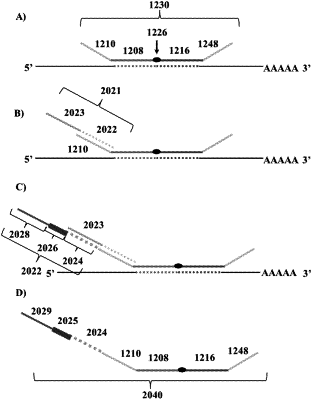| CPC G01N 33/532 (2013.01) [C07K 14/70539 (2013.01); C12N 15/1037 (2013.01); C12N 15/1055 (2013.01); C12N 15/1065 (2013.01); C12N 15/1075 (2013.01); C12N 15/11 (2013.01); C12N 15/85 (2013.01); C12Q 1/6804 (2013.01); C12Q 1/6806 (2013.01); C12Q 1/6818 (2013.01); C12Q 1/6827 (2013.01); C12Q 1/6881 (2013.01); G01N 33/505 (2013.01); G01N 33/5032 (2013.01); G01N 33/5304 (2013.01); G01N 33/5306 (2013.01); G01N 33/5308 (2013.01); G01N 33/548 (2013.01); G01N 33/54306 (2013.01); G01N 33/54366 (2013.01); G01N 33/56977 (2013.01); G01N 33/58 (2013.01); C12N 2310/20 (2017.05); C12N 2320/10 (2013.01); C12Q 2537/164 (2013.01); C12Q 2563/179 (2013.01); C12Q 2563/185 (2013.01); C12Q 2565/1015 (2013.01); C40B 30/04 (2013.01); C40B 50/06 (2013.01); C40B 70/00 (2013.01)] | 30 Claims |

|
1. A method of analyzing a sample comprising a cell or an isolated cell nucleus comprising a nucleic acid molecule, comprising:
(a) providing:
(i) the sample comprising the cell or the isolated cell nucleus comprising the nucleic acid molecule, wherein the nucleic acid molecule comprises a first target region and a second target region, and wherein the first target region and the second target region are both disposed on a strand of the nucleic acid molecule;
(ii) a first probe comprising a first probe sequence and a second probe sequence, wherein the first probe sequence of the first probe is complementary to the first target region of the nucleic acid molecule;
(iii) a second probe comprising a third probe sequence, wherein the third probe sequence is complementary to the second target region of the nucleic acid molecule;
(iv) a barcode oligonucleotide comprising: (1) a first barcode sequence that identifies the sample and (2) a third sequence;
(v) a splint oligonucleotide comprising:
(A) a first splint sequence complementary to the second probe sequence of the first probe, and
(B) a second splint sequence complementary to the third sequence;
wherein, in the cell or the isolated cell nucleus:
(i) the first probe sequence of the first probe is hybridized to the first target region of the nucleic acid molecule,
(ii) the third probe sequence of the second probe is hybridized to the second target region of the nucleic acid molecule,
(iii) the first splint sequence of the splint oligonucleotide is hybridized to the second probe sequence of the first probe, and
(iv) the second splint sequence of the splint oligonucleotide is hybridized to the third sequence of the barcode oligonucleotide;
(b) using the first probe, the second probe, and the barcode oligonucleotide to generate an additional nucleic acid molecule comprising the first probe, the second probe, and the barcode oligonucleotide; and
(c) using the additional nucleic acid molecule and a polynucleotide that comprises a second barcode sequence to generate a barcoded nucleic acid molecule comprising (i) a sequence corresponding to the first target region and the second target region, (ii) the first barcode sequence or reverse complement thereof, and (iii) the second barcode sequence or reverse complement thereof, wherein the second barcode sequence or reverse complement thereof identifies the cell or isolated cell nucleus.
|